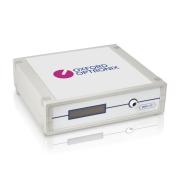Oxygen monitoring - Chronically implantable sensors: going beyond acute tissue oxygen monitoring
Introduction
The advent of chronically implantable sensors has the potential to revolutionize the field of biomedical investigative research. They offer unique opportunities for real-time, continuous monitoring of physiological parameters, thereby providing a more nuanced understanding of biological processes and disease progression.
In this article we review why scientists may want to consider implantable sensors and we discuss our background in chronic tissue pO2 measurements, evidenced by numerous publications.
Chronic studies versus acute studies
In contrast to acute measurement methods, chronically implantable sensors enable longitudinal measurements in awake, freely moving animals. This approach mitigates the confounding effects of anesthesia, which can alter physiological states such as heart rate and blood pressure, thus potentially providing more representative data. Implantable sensors also allow the capture of dynamic changes over time from the same tissue area, adding a crucial temporal dimension to the data that acute methods lack. This capability is particularly valuable in longitudinal studies, where understanding the progression of diseases or the effects of treatments over time is essential.
By facilitating detailed, continuous monitoring of physiological parameters, implantable sensors support more accurate and comprehensive research outcomes, ultimately contributing to better scientific understanding and medical advancements.
Chronically implantable oxygen sensors
Chronically implantable sensors, such as the ones developed for the OxyLite™ oxygen monitor, are emerging as essential tools in many areas of research, providing invaluable insights into physiological processes that were previously inaccessible. Understanding how oxygen levels are responding in specific tissues and organs over time has been of great interest to scientists. Several teams worldwide have been using implantable pO2 sensors in mouse, rat, pig, and sheep models, to make longitudinal measurements in a variety of applications. Below we provide examples involving cerebral monitoring applications.
Select publications
Ortiz-Prado E. et al. 2010 (Journal of Neuroscience Methods)
A method for measuring brain partial pressure of oxygen in unanesthetized unrestrained subjects: The effect of acute and chronic hypoxia on brain tissue pO2
This was one of the first publications to show our small implantable oxygen sensors for use in a rodent model. The paper demonstrated the small fiberoptic pO2 sensors performed remarkably well in a variety of simple applications and posed no issue to the surrounding brain tissue as shown in both an MRI and through histological analysis.

Villa B. et al. 2023 (Nature Scientific Reports)
Repeated episodes of postictal hypoxia are a mechanism for interictal cognitive impairments
This article investigates postictal severe hypoxia and how to help limit the overall severity of these events. To study the severity following a seizure event implantable pO2 sensors were used to monitor Hippocampal oxygen levels.
The authors find brain oxygen levels were kept above “the critical 10 mmHg level” of postictal severe hypoxia with both acetaminophen and nifedipine. They further illustrate that Interictal hippocampal pO2 decreases with repeated seizures and this can also be prevented by blocking postictal severe hypoxia.

Barakat R. et al. 2024 (Neuroscience Letters)
Low oxygen in inspired air causes severe cerebrocortical hypoxia and cell death in the cerebral cortex of awake rats
This article explores the consequences in the brain of breathing low levels of inspired oxygen for 48h, mimicking severe respiratory failure.
With use of the OxyLite™ and implantable oxygen sensors the authors were able to demonstrate the effect of low oxygen breathing on cortical oxygen levels. Interestingly, a gradual rise in cortical oxygen is seen over the 2-day experiment.

Moretti E. et al. 2024 (Shock)
Interplay between brain oxygenation and the development of hypothermia in endotoxic shock
The authors delivered a hypotension-inducing dose of bacterial lipopolysaccharides (LPS) and observed the response in respect to hypothermia and pO2. The figure shows brain pO2 in LPS-challenged rats and its relationship to cerebral blood flow and pressure.
The team found that the hypothermic response takes place before brain oxygenation increases in the early phase of LPS-induced systemic inflammation. This data suggests that this sequence is consistent with a feedforward mechanism aimed at preventing tissue hypoxia.

Jansen N. et al. 2024 (PNAS)
Brainstem depolarization–induced lethal apnea associated with gain-of-function SCN1AL263V is prevented by sodium channel blockade
In this publication the authors used an implanted OxyLite oxygen sensor to better understand sudden apnea lethality in infants. Oxygen in the cortex and the medulla seem to show that brain hypoxia, in sudden apnea, is a consequence of the apnea itself rather than a leading cause of the brainstem depolarization event in this model.

Jufar A. et al. 2022 (Acta Physiologica)
Influence of moderate hypothermia on renal and cerebral haemodynamics and oxygenation during experimental cardiopulmonary bypass in sheep
Here the authors sought to understand if hypothermia may be used to alleviate organ hypoxia following cardiopulmonary bypass in clinically relevant sheep. Sensors were pre-implanted into cerebral cortex, renal cortex, and renal medulla to measure local tissue perfusion, oxygenation, and temperature.
Interestingly the team found that moderately hypothermic cardiopulmonary bypass did not significantly improve cerebral tissue oxygenation.

The OxyLite™ monitor
There is good reason our OxyLite™ platform has been used so extensively in the arena of in vivo cerebral research. This system provides incredibly useful real-time data that relays important physiological parameters to scientists about brain health and function.

The system continues to be used and trusted by a worldwide user-base in research institutes, universities, hospitals, pharma, CRO’s, and within military research circles.
Implantable oxygen sensors
For those performing chronic oxygen studies of the brain, implantable sensors offer a way to take serial measurements over time. The sensor length can be defined to support oxygen measurements at the desired tissue depth.

Sensors are surgically implanted. After a short recovery period, measurements can then be taken in awake, restrained, or anesthetized models by connecting the miniature exteriorized sensor ferrule to a dedicated adapter, itself attached to the OxyLite™ oxygen monitor.


